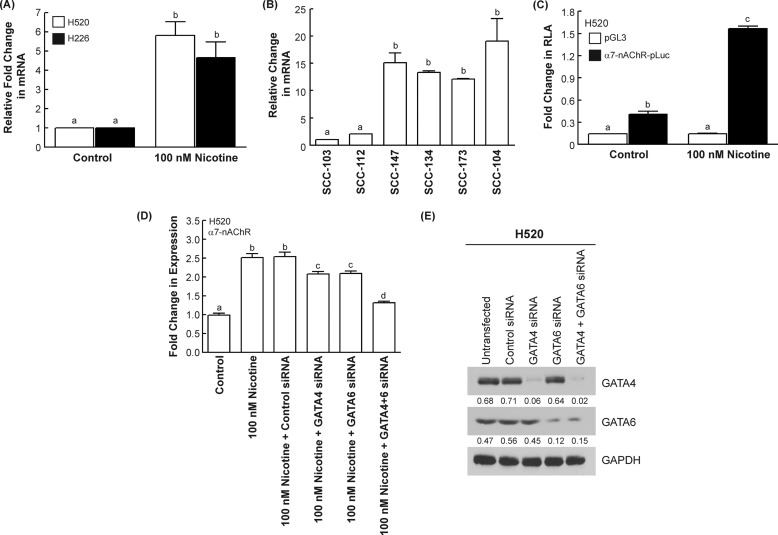FIGURE 2.
Nicotine increased the transcriptional activity of α7-nAChR promoter in human SCC-L cells. A, real-time PCR analysis revealed that the treatment of human SCC-L cell lines (H520 and H226) with 100 nm nicotine increased the levels of α7-nAChR mRNA in 72 h. B, the levels of α7-nAChR mRNA in human SCC-L tumors was correlated with the smoking history of the patients. C, luciferase reporter assays (RLA) demonstrated that nicotine induces luciferase activity in human SCC-L cells. H520 cells were transfected with the bovine α7-nAChR promoter construct, α7-promoter (bovine)-LUC. The addition of 100 nm nicotine potently increased nicotine-induced relative luciferase activity (firefly luciferase/renilla luciferase ratio) at 48 h. D, depletion of GATA4 and GATA6 by siRNA methodology reversed nicotine-induced up-regulation of α7-nAChR in H520 human SCC-L cells. The transfection of GATA4 siRNA (or GATA6 siRNA) individually had a minimal effect on the nicotine-induced increase of α7-nAChR (fourth and fifth bar from the left). However, the combination of GATA4 and GATA6 siRNA abrogated nicotine-induced increase in α7-nAChR expression. No effect was observed when the H520 human SCC-L cells were transfected with a control non-targeting siRNA. The figure represents the average of two independent experiments, and the data have been represented as the mean ± S.E. Results indicated by a different letter are significantly different (p < 0.05). E, Western blotting experiments revealed that the transfection of GATA4 and GATA6 siRNA suppressed the expression of these proteins in H520 cells. The Western blot was quantitated by densitometric analysis using NIH ImageJ 1.46p. The experiment was repeated twice, and the representative data are shown.

